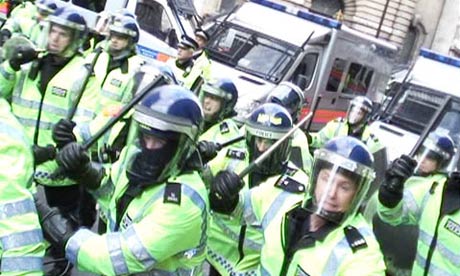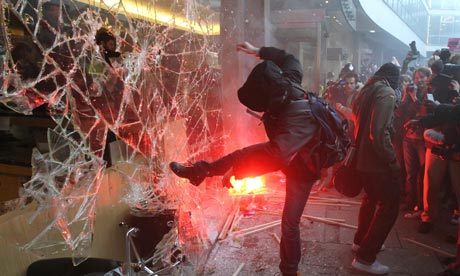22/02/2015
COP part two: considering themes
After my recent essay tutorial it was suggested that it might be more helpful and interesting to take the broad range of subjects from my essay and collate them into one diagram, in a style reminiscent of the Harry Campbell piece I looked at in my essay or for example Grayson Perry, rather than stick to one. Now I have done some research into riots and protesting I will consider and research the broader spectrum. Even if that research does not make its own project it may well be able to form part of this one, if it goes ahead.
COP part two: research
A section of my essay dealt with the idea that consumerism was and is a major factor in rioting, perhaps regardless of supposed intention. From this I have started to look at riots in general, though perhaps I will focus ones on British soil, for a little bit of structure.
QUOTES
FACTS + STATISTICS
SIGNIFICANT MOMENTS
LOCATIONS
A
section of my essay dealt with the idea that consumerism was and is a major
factor in rioting, perhaps regardless of supposed intention. From this I have
started to look at riots and protest in general, though perhaps I will focus
ones on British soil, for a little bit of structure.
· How much effect do protests /
riots make, and how does violence affect this?
QUOTES
- "they did not rebel against consumerism- but made
a (misguided and doomed) attempt to join, if only for a fleeting moment,
the ranks of consumers for which they have been excluded"
Zygmunt Bauman
- Speaking outside New Scotland Yard, the Metropolitan police commissioner, Sir Paul Stephenson, said the force should have anticipated the level of violence "better", adding: "It is not acceptable. "It's an embarrassment for London and for us."
- The NUS president, Aaron Porter, today condemned the actions of "those who are here to cause trouble." He tweeted: "Disgusted that the actions of a minority of idiots are trying to undermine 50,000 who came to make a peaceful protest."The NUS president said the march was the biggest student demonstration in generations, telling protesters: "We're in the fight of our lives ... we face an unprecedented attack on our future before it has even begun."They're proposing barbaric cuts that would brutalise our colleges and universities."
- "What’s very striking is that, looking at the records of Scuttling over a 30-year period, you seldom find a clerk or an apprentice being arrested. It was always those lads in that huge swathe of society for whom there were very few opportunities, and had no political rights. So if you like, staking out a claim to territory was one of the very few opportunities to 'be somebody' and be respected - even if that was to be feared… That was the case in the late 19th Century and I would say absolutely remains the case today” Andrew Davies on Scuttlers
- “With Section 2 violent disorder it’s the actions of a number of people taken together that the jury is encouraged to look at. And one of the difficulties the prosecution – and to an extent the police – have in these sorts of cases is that they view the crowd as one unit. They fail to see there are individuals within that crowd, like these two young men, who were trying to protect people and stop them getting hurt. They just viewed them as one large anonymous block.” Tom Wainwright on the student protests and the case of Alfie Meadows
·
FACTS + STATISTICS
· “Throughout the second half of the 1980s Thatcher continued
her policy of de-industrialisation in favour of imports from abroad,
effectively destroying British industry at the cost of thousands of jobs, with
unemployment reaching over 11% in the UK and about 50% in mining communities by
the late 80s.”
· “The
average heroin use in ex-mining communities is also documented as being 27%
above the national average, with usage in Wakefield, an area of West Yorkshire,
increasing by 3361% between 2000 and 2004. Wakefield was also classed in an EU
report of being one of the most deprived areas of Europe, along with
Grimethorpe in South Yorkshire and Knowsley in Merseyside, all ex-mining
communities.”
· 51
were injured and 93 arrested at the Battle of Orgreave. 72 police officers were
injured. There were between 5000 and 6000 strikers, with 4000 and 8000 police
officers,
· 153
people were arrested at the 2010 Student Fees Protests. Approximately 50,000
protesters turned up.
- The 2011 England Riots saw 5 deaths, 16 public injuries and 186 police officers injured.
SIGNIFICANT MOMENTS
- The Battle of Bogside / Northern Ireland riots (1969)
- Battle of Orgreave (1984)
- The miner's strike ends (1985)
- Student Fees Protests (2010)
- England Riots (2011)
PEOPLE
OF NOTE
·
Scuttlers- street gangs of 1890s Manchester. One of the first
youth cultures and not dissimilar to gang culture of today
·
Arthur Scargill
·
Margaret Thatcher
·
David Cameron
·
Nick Clegg
OBJECTS + ARTEFACTS
OBJECTS + ARTEFACTS
 |
| phones + social media |
 |
| riot gear + batons |
LOCATIONS
·
Manchester (1890s) (Scuttlers)
·
Northern Ireland (1969)
·
Orgreave (1984)
20/02/2015
COP part two: map of understanding
Whilst my essay was broad in looking at happiness and consumerism it has also been suggested that I look at a smaller subsection within the essay and expand on that.
I found when trying to make a map of understanding for "happiness and consumerism" that I was just rewriting the points from my essay. Not for lack of potential research, but rather it is really so broad that I keep getting lost in these ideas and don't know how to expand something already so expansive.
On the other hand I found taking something smaller and going deeper into that will be a far more straightforward, and perhaps more interesting, way of approaching the second part of COP. A section of my essay dealt with the idea that consumerism was and is a major factor in rioting, perhaps regardless of supposed intention.
I'm not sure where I'm going with this yet, but have noticed recurring themes of gang culture, the unprivileged and riots and protest- which follows nicely from the Zygmunt Bauman quote featured in my essay. I've also found some information about 'Scuttlers', arguably the first youth gangs of Britain, and how they parallel with those of today.
A lot of this information on this map is to do with the protest 'aspirations' and the social problems that caused them, e.g. student fees and Thatcherism. I would like to look more into protests/ riots in general and how they function regardless of cause, otherwise this project may well just become a list of protests through the ages.
Subscribe to:
Posts (Atom)








.JPG)
.JPG)